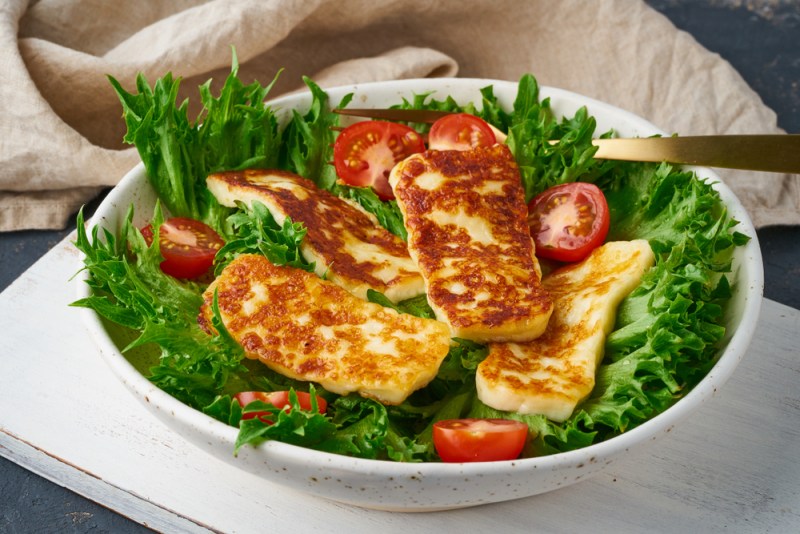What is Halloumi Cheese?
Grilling cheese seems absurd. You would expect the slices of halloumi to start melting almost instantly. Instead, this creamy, chewy, mild cheese picks up great grill marks and a touch of smoky flavor. Halloumi is trending right now, and for a good reason – it’s delicious! Halloumi is a a semi-hard, brined, and springy white cheese with origins in the Middle Eastern country of Cyprus. It is traditionally made from sheep and goat milk. It has a thick texture similar to feta or mozzarella. Grilling and frying halloumi is possible due to the lack of acid during preparation, which results in an extremely high melting point.
How Is It Made?
To make halloumi, milk is heated and then rennet, or vegetarian rennet, is added. Once cooled, the curds and whey naturally separate. The curds are then left to firm up, after which they are poached in the original whey with a little salt, and then kept in brine in order to preserve the cheese for longer.

Shutterstock/DanielFox
What Does Halloumi Cheese Taste Like?
Uncooked, halloumi cheese is salty and bitter from the brine. Cooked, however, halloumi is stripped from its strong, salty flavor and reveals a very strong savory flavor with a nice creamy texture.
Where Can You Buy It?
You might have some difficulty finding halloumi cheese in your local grocery store, however, you maybe able to find it at Whole Foods and Trader Joe’s. Halloumi cheese will run you close to $8 at Whole Foods, which is already more of an elite grocery option. At Trader Joe’s, prices are a little better, for only $4.99; But it is an ounce smaller than industry standards (8 oz).
Why Is Halloumi Cheese So Expensive?
The reason behind the high price point is that halloumi is made almost exclusively in Cyprus, and lack of infrastructure exists for getting goods out of Cyprus to Greece and beyond. Also, halloumi is made from sheep and goats’s milk, which is more expensive than cow’s milk due to a lower milking yield. Furthermore, halloumi is often aged, which can also raise the price. And finally, there has been an increased demand and with Cypriot banks failing, there has been little money to invest in the halloumi industry. This results in few opportunities for it to expand. More demand for halloumi than the ability to produce it, puts it at a premium.

Shutterstock/Nata Bene
Halloumi Cheese Nutritional Facts
A healthy portion size of halloumi is about 80g, roughly a palm-sized piece, but it isn’t advisable to eat it every day due to its high saturated fat and salt content.
- Calories – approx. 192
- Fat – approx. 15.2 g – 10.4 g of that is saturated fat
- Carbohydrates – approx. 1.75 g
- Sodium – approx. 265 mg (Olympus is a reduced-salt halloumi)
- Sugar – approx 0.6 mg of sugar
- Protein – approx. 12.3 g
The NHS recommends that men should consume no more than 30g of saturated fat a day, and women 20g. So, while halloumi can be enjoyed as part of a balanced diet, it’s best not to have it more than once a week. This will also help you to keep your salt intake down.
How Do You Eat Halloumi Cheese?
Halloumi can be eaten raw, however, it is truly delicious cooked. Grilled halloumi is most popular, but you can also eat it pan-fried or thinly sliced. Once you have familiarized yourself with the unique taste of halloumi, try experimenting with it in salads, kebobs, and various other dishes. Below are grilling instructions as well as some of our favorite recipes!
Recipes
- Grilled Halloumi Cheese
- The Traditional Cyprus Sandwich
- Traditional Watermelon and Halloumi
- One-Pan Basil Halloumi Chicken
- Farro and Halloumi Salad
- Halloumi And Vegetables Skewers
Can You Substitute For It?
In flavor, halloumi is similar to many other fresh milk cheeses. When made with sheep or goat milk, its mild flavor gains a tangy quality. Halloumi is also fairly salty, more so than mozzarella but less than feta. A good halloumi cheese substitute should have a high melting point and is suitable for frying and grilling.
Halloumi alternatives include:
- Cheese Curds
- Paneer
- Queso Fresco
- Feta.
Other possible cheeses that are similar to halloumi include the Pasta Filata cheeses such as:
- Mozzarella
- Provolone
- Oaxaca
- Caciocavallo Silano
- Pallone di Gravina
